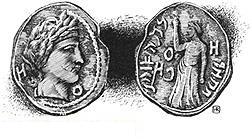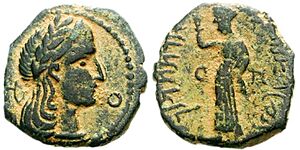Aretas IV Philopatris facts for kids
Aretas IV Philopatris was a powerful king of the Nabataeans. He ruled for a long time, from about 9 BC to AD 40. His full name, "Philopatris," meant "friend of his people" in Nabataean Aramaic. The Nabataeans were an ancient Arab people who built amazing cities.
Aretas IV had a daughter named Phasaelis. She was married to a ruler named Herod Antipas. But Herod Antipas later divorced her to marry another woman, Herodias. This marriage was controversial and even led to the death of John the Baptist. When King Aretas heard about the divorce, he attacked Herod Antipas's land and won a big battle.
Contents
Becoming King: How Aretas IV Rose to Power
Aretas became king after the previous ruler, Obodas III, was likely poisoned. An ancient writer named Josephus said that Aretas was originally named Aeneas. But he changed his name to "Aretas" when he became king. Some old writings from Petra suggest he was part of the royal family. He might have been a descendant of an earlier king, Malichus I.
The capital city of Aretas's kingdom was Petra. Petra was a very rich trading city, located about 170 miles south of Amman. It is famous for its many amazing buildings carved right into the rose-red sandstone cliffs. The Nabataeans controlled important trade routes. These routes stretched south and east of Judea for many centuries.
Aretas's full title was "Aretas, King of the Nabataeans, Friend of his People." He was the strongest neighbor of Judea. Because of this, he often got involved in Judea's politics. He helped shape what happened to its rulers.
Aretas didn't always get along well with Rome. The Roman emperor Augustus was slow to recognize him as king. But Aretas still helped Rome. He sent a large army to help the Roman general Varus fight against the Jews in 4 BC.
King Aretas had two wives. His first wife was Huldu. She was already his wife when he became king. Her face appeared on Nabataean coins until AD 16. After a few years, the face of his second wife, Shaqilath, started appearing on the coins.
Conflict with Herod Antipas: The Battle and Its Aftermath
As mentioned, Aretas's daughter, Phasaelis of Nabataea, married Herod Antipas. Herod Antipas was also known as Herod the Tetrarch. Phasaelis ran away to her father when she found out her husband planned to divorce her. He wanted to marry Herodias, who was the mother of Salome. Herodias was already married to Herod Antipas's brother, Herod II.
Herod Antipas married Herodias. Many people were against this marriage. It even led to John the Baptist being beheaded.
King Aretas then attacked Herod Antipas's land. He defeated Herod's army. This happened partly because soldiers from another region helped King Aretas. Herod Antipas was only able to escape with help from Roman forces.
Herod Antipas then asked the Roman Emperor Tiberius for help. Emperor Tiberius sent the governor of Syria, Lucius Vitellius the Elder, to attack Aretas. Vitellius gathered his armies and started moving south. He stopped in Jerusalem in AD 37. While there, he heard that the emperor had died. Because of this, the attack on Nabataea was never finished.
The Christian Apostle Paul wrote about having to escape from Damascus. He said he had to sneak out in a basket through a window in the wall. This was to escape an official of King Aretas. Historians are still debating if Aretas truly controlled the city of Damascus at that time.
Aretas IV died in AD 40. His son, Malichus II, and daughter, Shaqilath II, became the next rulers.
Images for kids
See also
 In Spanish: Aretas IV para niños
In Spanish: Aretas IV para niños







